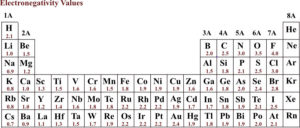Electronegativity, EN, is the ability of an atom in a molecule to attract the shared electrons in a covalent bond. Electronegativity values for the elements are in the figure below. Note, electronegativity increases going across a period, and it decreases going down a group. There are some exceptions, but generally you only need to remember the periodic trends.
Fluorine is the most electronegative element on the periodic table with an electronegativity value of 4.0. The electronegativity values on the table above, were determined using the Pauling scale which is unit-less. The values are calculated from other properties of the elements such as bond dissociation energy and including ionization energy and electron affinities. The elements on the right hand of the periodic table, such as the chalcogens (Group 6A) and halogens have the highest electronegativity values.
Electronegativity differences between the atoms in a bond can indicate whether a bond is nonpolar, polar, or ionic. For example, the H-H bond is nonpolar because both atoms are the same and the electrons in the bond are said to be shared equally between both atoms. The electronegativity for H is 2.1 and 2.1 – 2.1 = 0. The bond C-S is also nonpolar because both C and S have an electronegativity value of 2.5 and 2.5 – 2.5 = 0.
Hydrogen chloride, H-Cl, is polar covalent. The electronegativity values for H and Cl are 2.1 and 3.0, respectively. The electronegativity difference is 3.0 – 2.1 = 0.9. The bonding electrons are drawn to the chlorine atom since it is more electronegative. This results in a partial negative charge, δ–, on the Cl atom and a partial positive charge, δ+, on the H atom. The H atom is said to be electropositive and the Cl atom is electronegative. We can represent H-Cl as:
In general:
Electronegativity differences between 0.5 and 1.9 are considered increasingly polar covalent bonds.
Electronegativity differences of 2 or greater than 2 are considered to be ionic bonds.
The higher the polarity of a bond, the stronger the bond. Many bonds have both covalent and ionic character. The percent of ionic character can be measured using the ratio of observed dipole moment to the calculated dipole moment when the charges are completely separated and then multiplying by 100.
Recall the calculated dipole moment, μ, is:
where Q is the charge magnitude and r, in m, is the distance between both charges. The charge on an electron is 1.6 x 10-19 coulombs, C. The unit for μ, is the Debye, D. One Debye is equal to 3.34 x 10-30 C⋅m.
We can calculate the percent ionic character for a AgCl bond with a dipole moment of 6.07 D and a bond length of 226 pm. First we calculate the dipole moment in C⋅m.
μ = Q x r = 1.60 x 10-19 C x (2.26 x 10-10 m) = 3.62 x 10-29 C⋅m
Next convert C⋅m to D.
\(\displaystyle 3.62\times\;10^{-29}\;C⋅m\times\frac{1\;D}{3.34\times\;10^{-30}\;C⋅m}\;=\;10.8\;D\)
The percent ionic character is:
\(\displaystyle \frac{6.07\;D}{10.8\;D}\times\;100\;=\;56.2\;\%\)
The AgCl bond is 56.2% ionic.
Worksheet: Bond Length, Bond Strength, and Electronegativity
Exercises
Exercise 1. Use periodic trends to order the following elements from smallest to largest electronegativity.
Check Solutions/Answers to Exercise 1.
Exercise 2. Classify each of the following bonds as nonpolar covalent, polar covalent, or ionic.
Al-Cl
P-O
H-S
Check Solutions/Answers to Exercise 2.
Exercise 3. Classify the following bonds as nonpolar, polar, or ionic.
Se-O
P-I
Rb-S
Check Solutions/Answers to Exercise 3.
Exercise 4. Calculate the percent ionic character for NaF. The dipole moment is 8.123 D and the distance between Na+ and F– is 231 pm.
Check Solutions/Answers to Exercise 4.
Exercise 5. Calculate the percent ionic character for KBr if the dipole moment is 10.603 D and the distance between K+ and Br– is 282 pm.
Check Solutions/Answers to Exercise 5.
Exercise 6. Use electronegativity values to determine which bond, Na-H or H-F, has the greater ionic character. You can then use the following data to check your answer:
Na-H: μ = 6.400 D, distance between ions = 190 pm
H-F: μ = 8.123 D, distance between ions = 92 pm
Check Solutions/Answers to Exercise 6.
Back to Covalent Bonds and Lewis Dot Structures
Back to General Chemistry 1 Study Guides
Back to Home Page

